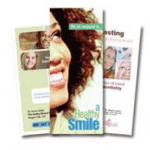Influence
We can influence patients consciously or subconsciously by the way in which we communicate with them. For example
The words we use
Whether the words are written or spoken, a patient’s perception can easily be influenced by the words that we choose to use. Some patients will be particularly reactive or sensitive to the use of certain words (eg. “cutâ€, “drillâ€, “injectâ€, “bleedingâ€, “painful†etc); when you are discussing a procedure face to face you can usually see this reaction, and deal with it there and then. But when you use the same words in a letter, you don’t get this opportunity.
Our voice
 The pace at which we speak, how loudly or softly, and how clearly we articulate our words, the pitch and timbre of our voice, can all influence how others might react to what we say. If we want to stress or emphasise something important, we should speak more slowly and clearly, and perhaps a little louder. This helps to differentiate this information from less critical discussions, during which we might speak a little quicker and with less emphasis.
The pace at which we speak, how loudly or softly, and how clearly we articulate our words, the pitch and timbre of our voice, can all influence how others might react to what we say. If we want to stress or emphasise something important, we should speak more slowly and clearly, and perhaps a little louder. This helps to differentiate this information from less critical discussions, during which we might speak a little quicker and with less emphasis.
In general, a higher pitch conveys nervousness or uncertainty, while a lower pitch – particularly when accompanied by speaking more slowly – tends to communicate calm, confident authority and a feeling that everything is under control.
Non verbal communication (“body languageâ€)
Our eyes, our face, our posture, our gestures, will all form part of the message that a patient receives when we are communicating with them. Sometimes deliberately, sometimes unconsciously, we send the patient non-verbal signals that either accentuate, or detract from the actual words we might have used. Good eye contact communicates honesty and sincerity whereas avoidance of eye contact suggests the reverse.
Images
Many dentists use leaflets, brochures and pictures, videos and commercial CD/DVD programmes, to complement any verbal explanations of procedures. These, too, can often lead a patient to form a particular opinion. Some (especially those sold with the intention of promoting the uptake of a particular form of treatment, rather than providing general information and patient education) are intended to make one form of treatment sound a lot more attractive than alternative options.
These visual aids can become pivotal evidence if and when a dispute arises over what a patient was and was not told, and the extent to which they might have been misled or denied important information. All the more reason, therefore, to reassess all the information material that you use, and to reflect upon how fair, balanced and accurate it is. The risk of a one-sided picture being created in the patient’s mind is greater when using material that has been created by manufacturers and suppliers. Not all such leaflets fall into this trap – but unfortunately for the dentists concerned, many do, making it much easier for the patient to suggest that they were “talked into†or “sold†some dentistry without having been made fully aware of its possible risks and limitations.
Respect
This brings together the ethical and human dimensions of consent, and can be summarised as dealing with patients as we would wish to be dealt with ourselves, or as we would hope and expect that another health professional might deal with us or a member of our family.
 It is not our right to carry out treatment on another person, without fully involving them in the decision-making process. It is not fair, moral or decent to deprive another person of their right of autonomy and self-determination. For a healthcare professional to act in such a way in relation to someone under their care is particularly unacceptable, given the special relationship of trust that exists (or should exist) between a patient and that healthcare professional.
It is not our right to carry out treatment on another person, without fully involving them in the decision-making process. It is not fair, moral or decent to deprive another person of their right of autonomy and self-determination. For a healthcare professional to act in such a way in relation to someone under their care is particularly unacceptable, given the special relationship of trust that exists (or should exist) between a patient and that healthcare professional.
Giving patients choices is one way of showing our respect for them, but a patient cannot exercise that choice unless they have sufficient, meaningful and balanced information to support that process.
In any relationship between a lay person and a professional person there tends to be a wide gulf between the relative levels of knowledge and understanding. It is the professional person’s responsibility to close that gap by being prepared to spend time and effort in sharing their special knowledge of the procedure(s) in question, and their likely outcome, so that the patient is better placed to understand the options available to them.
Making this investment of time and effort helps to build a stronger relationship of trust and confidence between you and the patient, as well as laying the foundations for an effective, valid consent process.
